ECU MAZDA MODEL CX-7 2007 Quick Tips (in English)
[x] Cancel search | Manufacturer: MAZDA, Model Year: 2007, Model line: MODEL CX-7, Model: MAZDA MODEL CX-7 2007Pages: 14, PDF Size: 1.77 MB
Page 6 of 14
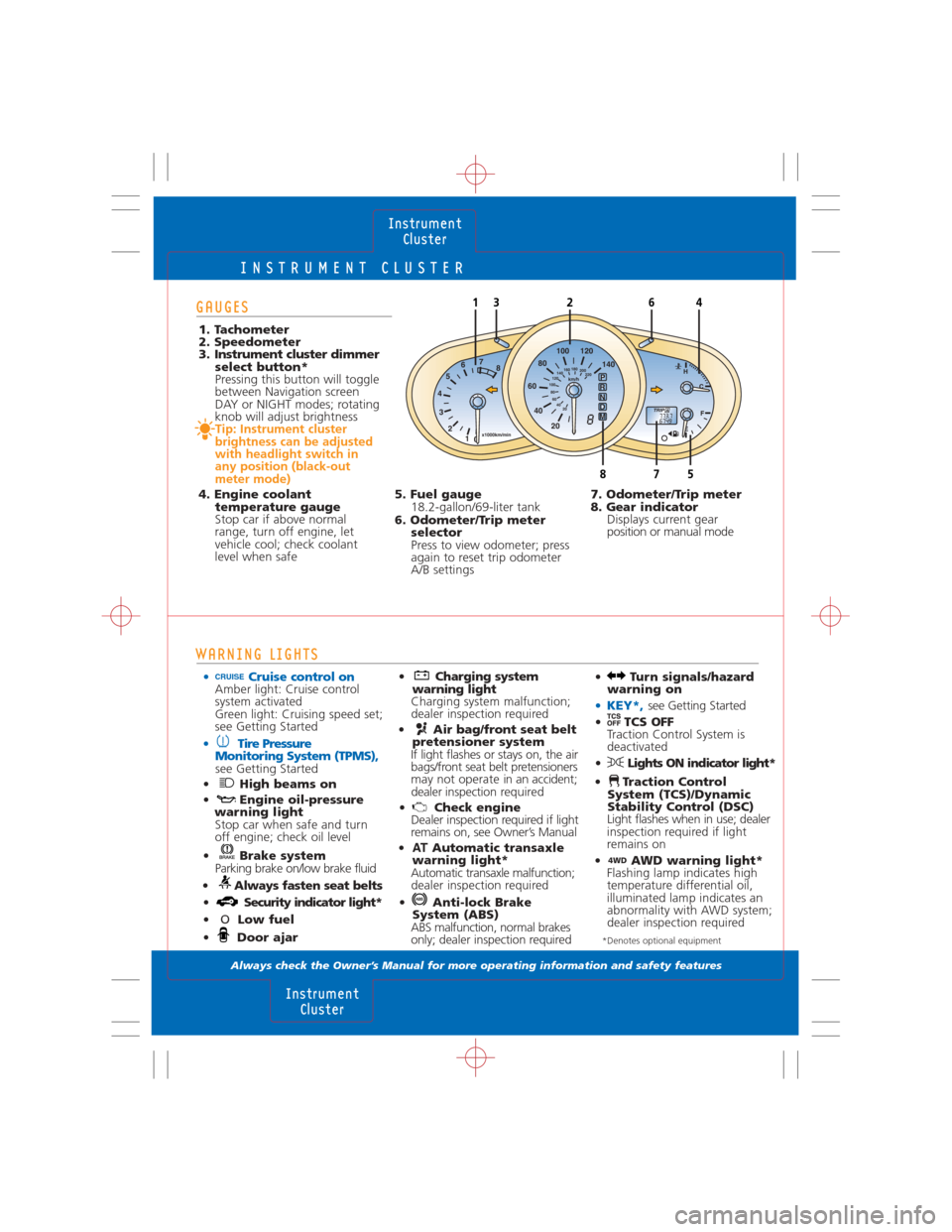
INSTRUMENT CLUSTER
Always check the Owner’s Manual for more operating information and safety features
WARNING LIGHTS
• Cruise control onAmber light: Cruise control
system activated
Green light: Cruising speed set;
see Getting Started
• Tire Pressure Monitoring System (TPMS),
see Getting Started
• High beams on • Engine oil-pressure warning lightStop car when safe and turn
off engine; check oil level
• Brake system Parking brake on/low brake fluid
• Always fasten seat belts • Security indicator light*
• OLow fuel
• Door ajar
GAUGES
1. Tachometer
2. Speedometer
3. Instrument cluster dimmer select button*
Pressing this button will toggle
between Navigation screen
DAY or NIGHT modes; rotating
knob will adjust brightness
Tip: Instrument cluster
brightness can be adjusted
with headlight switch in
any position (black-out
meter mode)
4. Engine coolant temperature gauge
Stop car if above normal
range, turn off engine, let
vehicle cool; check coolant
level when safe
• Charging system warning light
Charging system malfunction;
dealer inspection required
• Air bag/front seat belt pretensioner system
If light flashes or stays on, the air
bags/front seat belt pretensioners
may not operate in an accident;
dealer inspection r equired
• Check engine Dealer inspection required if light
remains on, see Owner’s Manual
• AT Automatic transaxle
warning light*
Automatic transaxle malfunction;
dealer inspection required
• Anti-lock Brake System (ABS)
ABS malfunction, normal brakes
only; dealer inspection required
5. Fuel gauge 18.2-gallon/69-liter tank
6. Odometer/Trip meter selector
Press to view odometer; press
again to reset trip odometer
A/B settings
InstrumentCluster
Instrument Cluster
TRIPA773.7
67498
H140
8
7
6
5
4
3 2 10220
40
60
80
100
120
140
160
180
200
20
120
100
80
60
40 20 0
C
F
x1000km/min km/hE
P
R
N
D
M
785
12364
• Turn signals/hazard warning on
• KEY*,see Getting Started
• TCS OFF Traction Control System is
deactivated
• Lights ON indicator light*
• Traction Control System (TCS)/Dynamic
Stability Control (DSC)
Light flashes when in use; dealer
inspection required if light
remains on
•
4WDAWD warning light*
Flashing lamp indicates high
temperature differential oil,
illuminated lamp indicates an
abnormality with AWD system;
dealer inspection required
7. Odometer/Trip meter
8. Gear indicator Displays current gear
position or manual mode
CRUISE
*Denotes optional equipment
Page 7 of 14
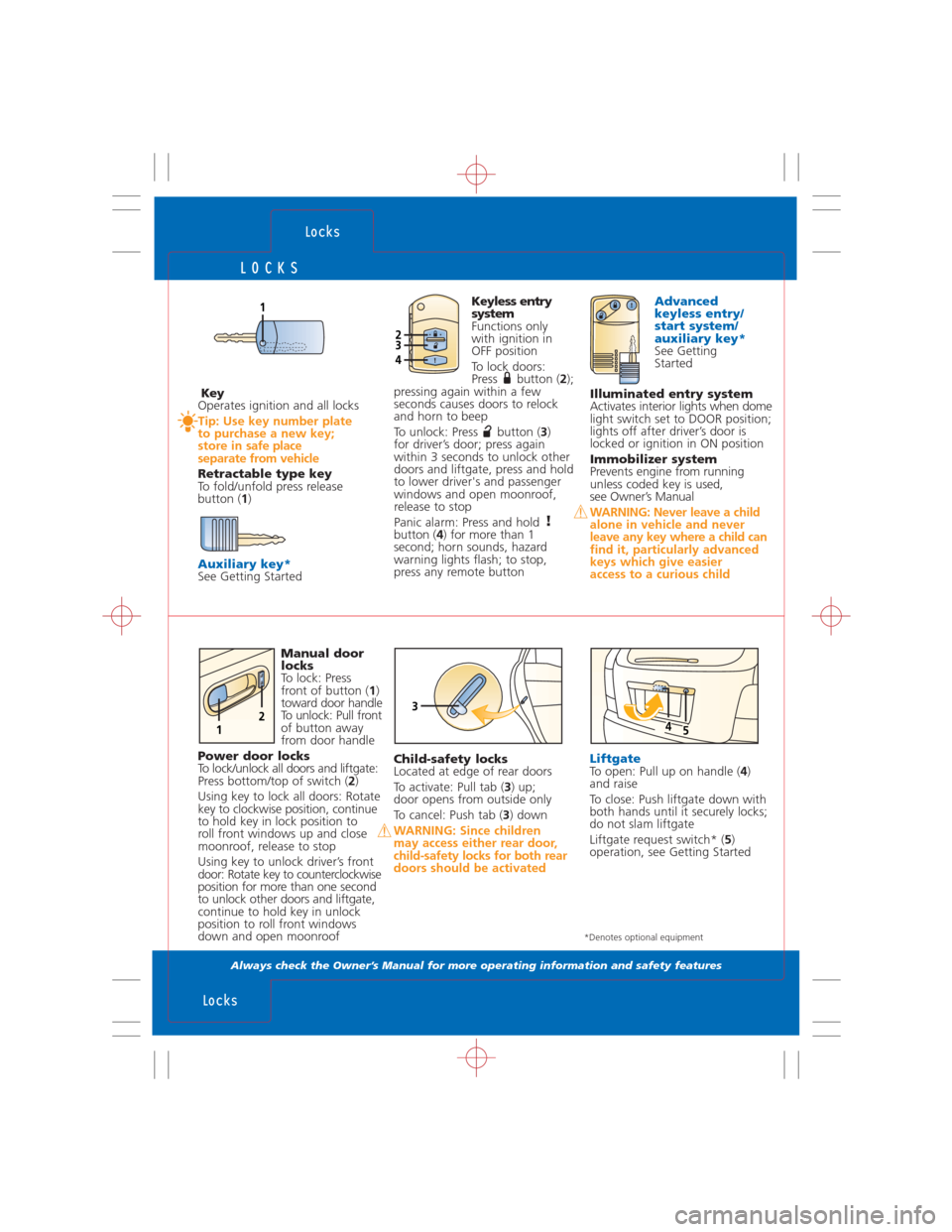
LOCKS
Always check the Owner’s Manual for more operating information and safety features
Child-safety locks
Located at edge of rear doors
To activate: Pull tab (3) up;
door opens from outside only
To cancel: Push tab (3) down
WARNING: Since children
may access either rear door,
child-safety locks for both rear
doors should be activatedLiftgate
To open: Pull up on handle (4)
and raise
To close: Push liftgate down with
both hands until it securely locks;
do not slam liftgate
Liftgate request switch* (5)
operation, see Getting Started
Locks
Locks
Key
Operates ignition and all locks
Tip: Use key number plate
to purchase a new key;
store in safe place
separate from vehicle
Retractable type key
To fold/unfold press release
button (1)
Auxiliary key*See Getting Started
Manual door
locks
To lock: Press
front of button (1)
toward door handle
To unlock: Pull front
of button away
from door handle
Power door locks
To lock/unlock all doors and liftgate:
Press bottom/top of switch (2)
Using key to lock all doors: Rotate
key to clockwise position, continue
to hold key in lock position to
roll front windows up and close
moonroof, release to stop
Using key to unlock driver’s front
door: Rotate key to counterclockwise
position for more than one second
to unlock other doors and liftgate,
continue to hold key in unlock
position to roll front windows
down and open moonroofKeyless entry
system
Functions only
with ignition in
OFF position
To lock doors:
Press button (2);
pressing again within a few
seconds causes doors to relock
and horn to beep
To unlock: Press button (3)
for driver’s door; press again
within 3 seconds to unlock other
doors and liftgate, press and hold
to lower driver's and passenger
windows and open moonroof,
release to stop
Panic alarm: Press and hold
button (4) for more than 1
second; horn sounds, hazard
warning lights flash; to stop,
press any remote button
3
45
Advanced
keyless entry/
start system/
auxiliary key*
See Getting
Started
Illuminated entry system
Activates interior lights when dome
light switch set to DOOR position;
lights off after driver’s door is
locked or ignition in ON position
Immobilizer system
Prevents engine from running
unless coded key is used,
see Owner’s Manual
WARNING: Never leave a child
alone in vehicle and never
leave any key where a child can
find it, particularly advanced
keys which give easier
access to a curious child
1
234
*Denotes optional equipment
21
Page 9 of 14
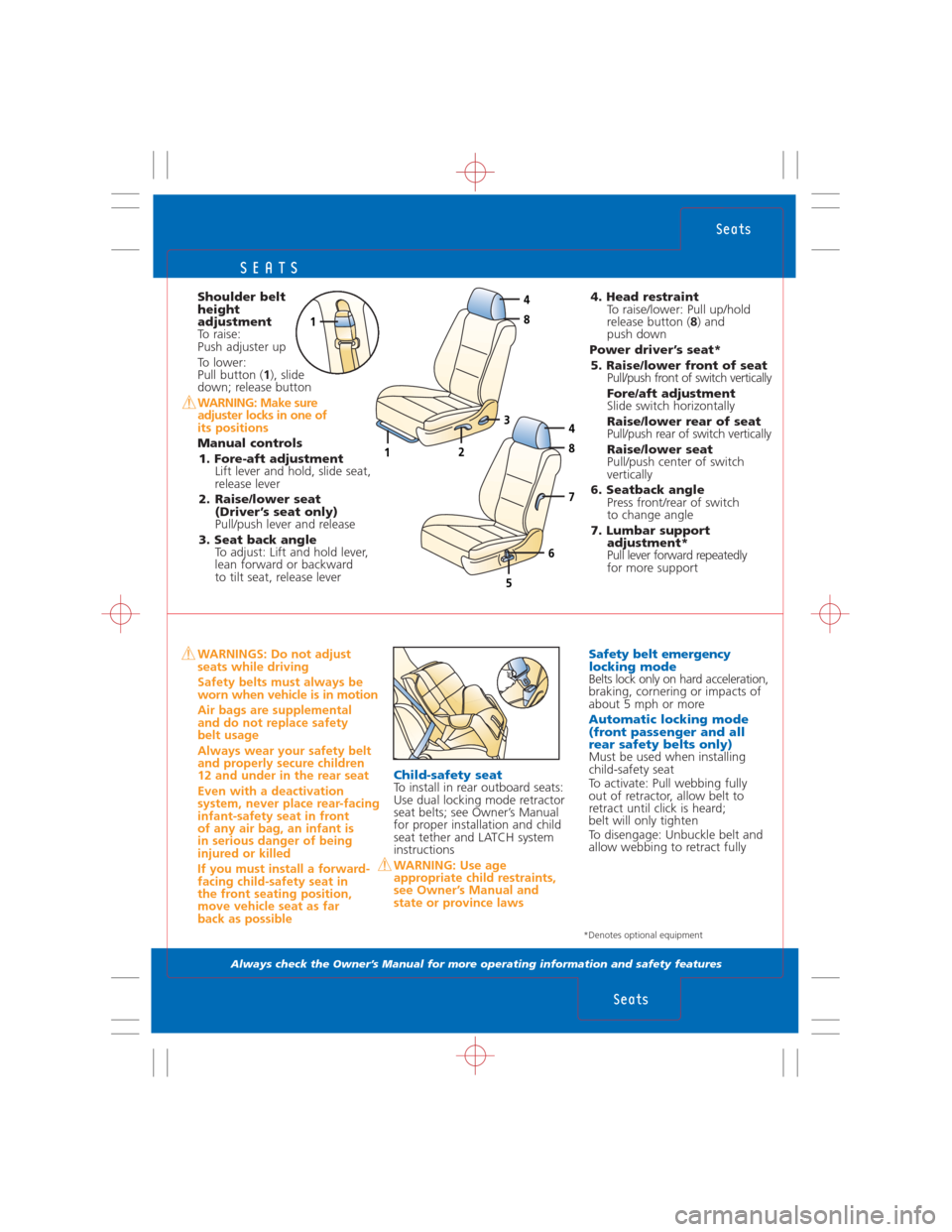
SEATS
Always check the Owner’s Manual for more operating information and safety features
Shoulder belt
height
adjustment
To raise:
Push adjuster up
To lower:
Pull button (1), slide
down; release button
WARNING: Make sure
adjuster locks in one of
its positions
Manual controls
1. Fore-aft adjustment
Lift lever and hold, slide seat,
release lever
2. Raise/lower seat
(Driver’s seat only)
Pull/push lever and release
3. Seat back angle
To adjust: Lift and hold lever,
lean forward or backward
to tilt seat, release lever4. Head restraint
To raise/lower: Pull up/hold
release button (8) and
push down
Power driver’s seat*
5. Raise/lower front of seat
Pull/push front of switch vertically
Fore/aft adjustment
Slide switch horizontally
Raise/lower rear of seat
Pull/push rear of switch vertically
Raise/lower seat
Pull/push center of switch
vertically
6. Seatback angle
Press front/rear of switch
to change angle
7. Lumbar support
adjustment*
Pull lever forward repeatedly
for more support
Seats
Seats
WARNINGS: Do not adjust
seats while driving
Safety belts must always be
worn when vehicle is in motion
Air bags are supplemental
and do not replace safety
belt usage
Always wear your safety belt
and properly secure children
12 and under in the rear seat
Even with a deactivation
system, never place rear-facing
infant-safety seat in front
of any air bag, an infant is
in serious danger of being
injured or killed
If you must install a forward-
facing child-safety seat in
the front seating position,
move vehicle seat as far
back as possibleSafety belt emergency
locking mode
Belts lock only on hard acceleration,
braking, cornering or impacts of
about 5 mph or more
Automatic locking mode
(front passenger and all
rear safety belts only)
Must be used when installing
child-safety seat
To activate: Pull webbing fully
out of retractor, allow belt to
retract until click is heard;
belt will only tighten
To disengage: Unbuckle belt and
allow webbing to retract fully
Child-safety seatTo install in rear outboard seats:
Use dual locking mode retractor
seat belts; see Owner’s Manual
for proper installation and child
seat tether and LATCH system
instructions
WARNING: Use age
appropriate child restraints,
see Owner’s Manual and
state or province laws
1
4
8
3
2
4
8
6
5
7
1
*Denotes optional equipment
Page 10 of 14
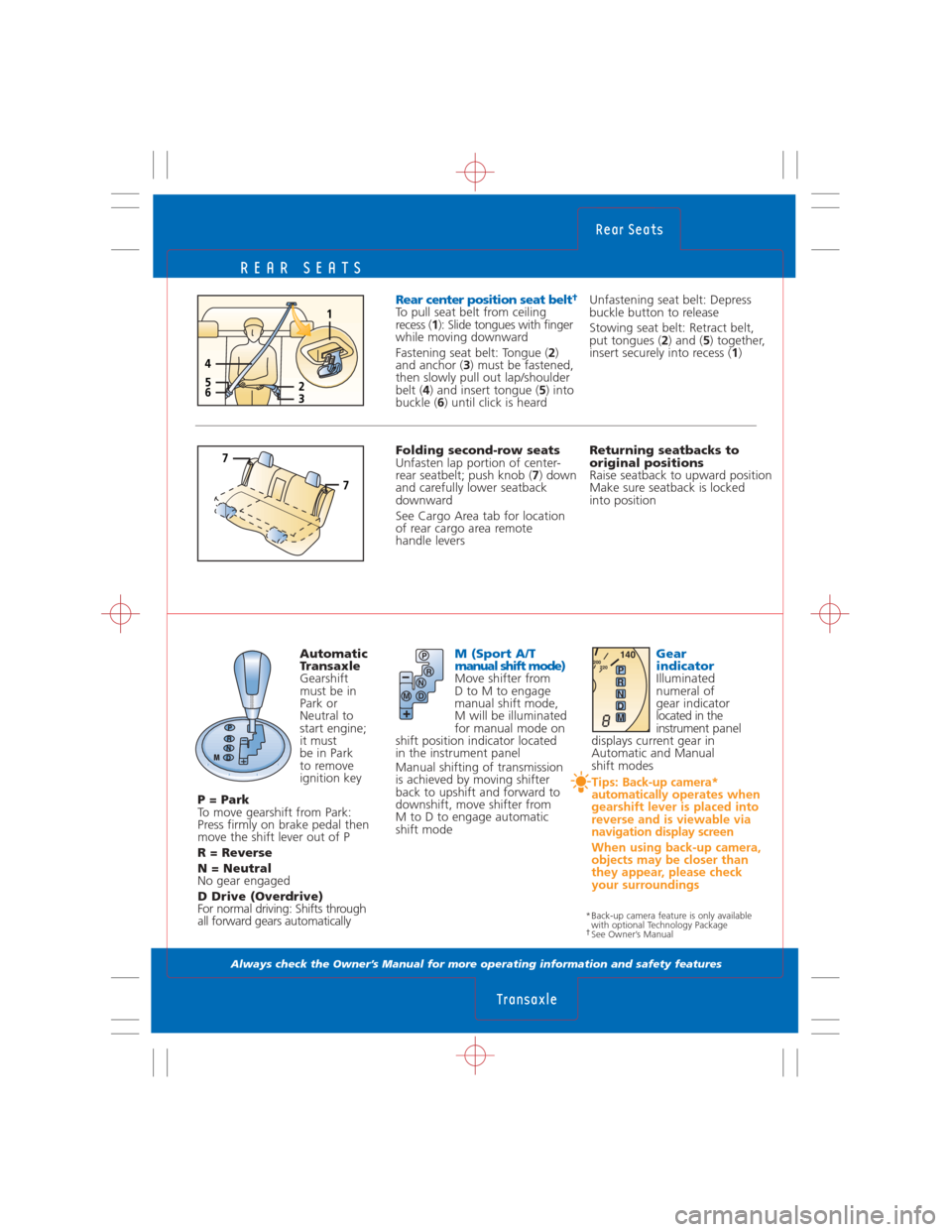
REAR SEATS
Always check the Owner’s Manual for more operating information and safety features
Automatic
Transaxle
Gearshift
must be in
Park or
Neutral to
start engine;
it must
be in Park
to remove
ignition key
P = Park
To move gearshift from Park:
Press firmly on brake pedal then
move the shift lever out of P
R = Reverse
N = Neutral
No gear engaged
D Drive (Overdrive)
For normal driving: Shifts through
all forward gears automatically
Rear Seats
Transaxle
Folding second-row seats
Unfasten lap portion of center-
rear seatbelt; push knob ( 7) down
and carefully lower seatback
downward
See Cargo Area tab for location
of rear cargo area remote
handle levers Returning seatbacks to
original positions
Raise seatback to upward position
Make sure seatback is locked
into position
Rear center position seat belt†
To pull seat belt from ceiling
recess (
1): Slide tongues with finger
while moving downward
Fastening seat belt: Tongue ( 2)
and anchor ( 3) must be fastened,
then slowly pull out lap/shoulder
belt ( 4) and insert tongue ( 5) into
buckle ( 6) until click is heard Unfastening seat belt: Depress
buckle button to release
Stowing seat belt: Retract belt,
put tongues (
2) and ( 5) together,
insert securely into recess ( 1)
M (Sport A/T
manual shift mode)
Move shifter from
D to M to engage
manual shift mode,
M will be illuminated
for manual mode on
shift position indicator located
in the instrument panel
Manual shifting of transmission
is achieved by moving shifter
back to upshift and forward to
downshift, move shifter from
M to D to engage automatic
shift mode
Gear
indicator
Illuminated
numeral of
gear indicator
located in the
instrument panel
displays current gear in
Automatic and Manual
shift modes
Tips: Back-up camera*
automatically operates when
gearshift lever is placed into
reverse and is viewable via
navigation display screen
When using back-up camera,
objects may be closer than
they appear, please check
your surroundings
P
R
N
D
M
8
140220
200P
R
N
D
M
*Back-up camera feature is only available with optional Technology Package
†See Owner’s Manual
7
7
2365
4
1
Page 13 of 14
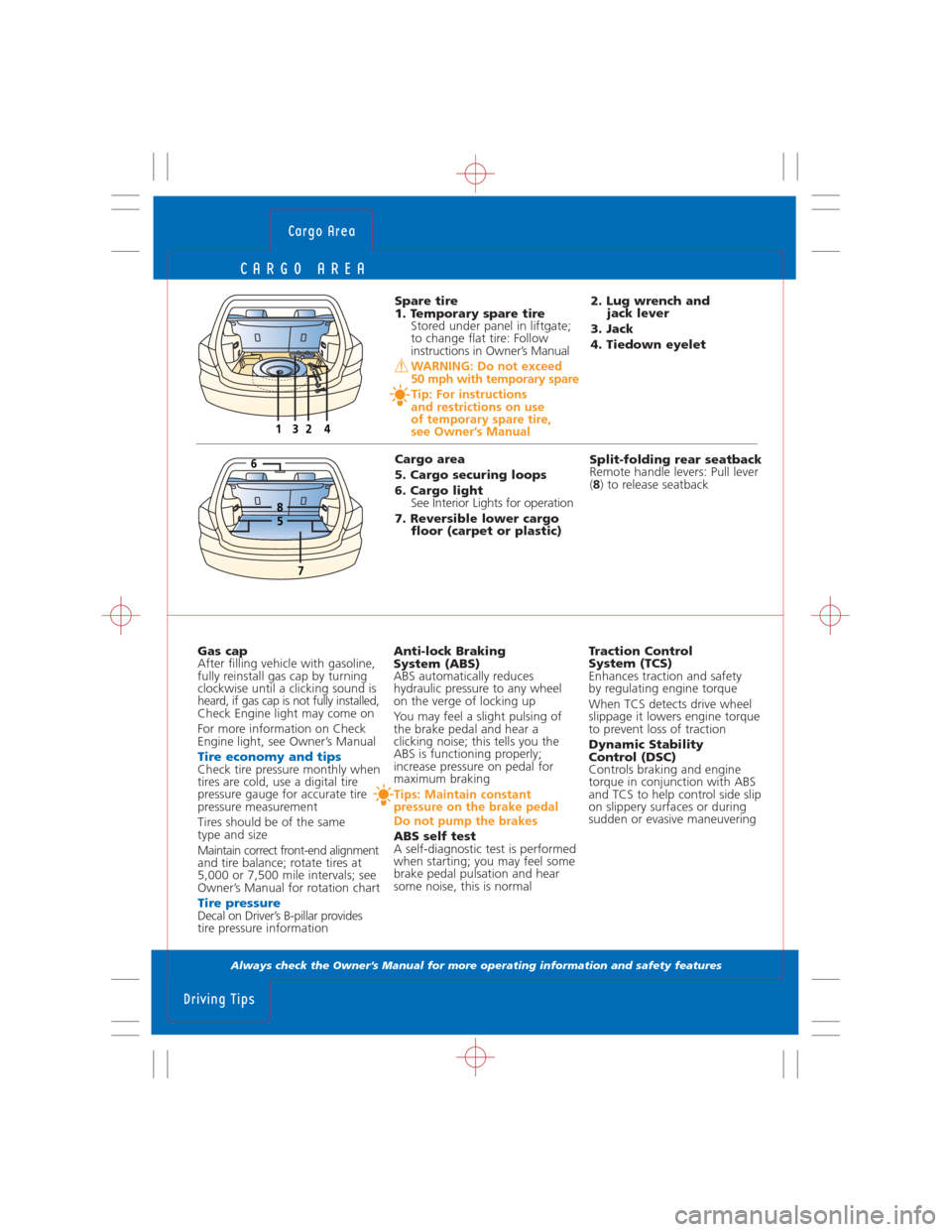
CARGO AREA
Always check the Owner’s Manual for more operating information and safety features
Cargo Area
Driving Tips
Spare tire
1. Temporary spare tire
Stored under panel in liftgate;
to change flat tire: Follow
instructions in Owner’s Manual
WARNING: Do not exceed
50 mph with temporary spare
Tip: For instructions
and restrictions on use
of temporary spare tire,
see Owner’s Manual
Gas cap
After filling vehicle with gasoline,
fully reinstall gas cap by turning
clockwise until a clicking sound is
heard, if gas cap is not fully installed,
Check Engine light may come on
For more information on Check
Engine light, see Owner’s Manual
Tire economy and tipsCheck tire pressure monthly when
tires are cold, use a digital tire
pressure gauge for accurate tire
pressure measurement
Tires should be of the same
type and size
Maintain correct front-end alignment
and tire balance; rotate tires at
5,000 or 7,500 mile intervals; see
Owner’s Manual for rotation chart
Tire pressure Decal on Driver’s B-pillar provides
tire pressure informationAnti-lock Braking
System (ABS)
ABS automatically reduces
hydraulic pressure to any wheel
on the verge of locking up
You may feel a slight pulsing of
the brake pedal and hear a
clicking noise; this tells you the
ABS is functioning properly;
increase pressure on pedal for
maximum braking
Tips: Maintain constant
pressure on the brake pedal
Do not pump the brakes
ABS self test
A self-diagnostic test is performed
when starting; you may feel some
brake pedal pulsation and hear
some noise, this is normal2. Lug wrench and
jack lever
3. Jack
4. Tiedown eyelet
Cargo area
5. Cargo securing loops
6. Cargo light
See Interior Lights for operation
7. Reversible lower cargo
floor (carpet or plastic)Split-folding rear seatback
Remote handle levers: Pull lever
(8) to release seatback
6
58
7
1324
Traction Control
System (TCS)
Enhances traction and safety
by regulating engine torque
When TCS detects drive wheel
slippage it lowers engine torque
to prevent loss of traction
Dynamic Stability
Control (DSC)
Controls braking and engine
torque in conjunction with ABS
and TCS to help control side slip
on slippery surfaces or during
sudden or evasive maneuvering